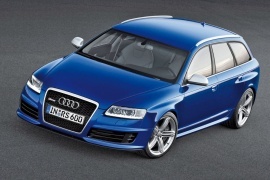
AUDI RS6 Avant
Generations Timeline, Specs and Pictures

One of the biggest successes with an RS badge in the history of Audi belongs to the acclaimed Audi RS6 Avant.
Apart from the first two generation of A6, the following received the RS badge only for the station wagon body. In 2019, Audi returned with the highly tuned supercar in this family-style bodywork.
Under the hood of the latest RS6 Avant there is a 4.0-liter TFSI engine. The twin-turbo unit offers a staggering 600 hp and 800 Nm (590 lb-ft) of torque. This energy is sent to the all-wheel-drive system via an 8-speed automatic gearbox. The central differential is fully mechanical and distributes the torque 40/60 front/rear. If needed, when a wheel slips, the differential can redirect the torque up to 70% to the front or 85% to the rear wheels.
Thanks to this high combination of technology and power, the RS6 Avant can do a 0-100 kph (0-62 mph) launch, with the launch control setting, in just 3.6 seconds. And in 12 seconds flat it can reach 200 kph (124 mph). The top speed is limited to 250 kph (155 mph).
For the suspension, the RS6 Avant has a five link system both front and rear, ensuring better roadholding. Standard wheels are of 21” fitted with 275/35 R21 tires.
The interior is fitted with top quality materials and bucket-type seats. The Audi MMI also integrates a part for performance measurements and supports Android Auto and Apple CarPlay.

The RS6 Avant was the true greyhound under a station-wagon skin.
It offered the performance of a supercar and the versatility of a family car.
The RS6 was the fastest station-wagon in the world at the time of its launch. It wasn’t powered by a Lamborghini engine anymore, but the car-maker installed a Bentley engine under its hood. Moreover, the RS6 was not offered as a sedan.
The Audi A6 Avant was somehow a bland looking car. It wasn’t that flamboyant or exclusive. With the RS6 the things were different. It was just like it was transformed all of a sudden from Clark to Superman. The big wheels, enlarged wheel-arches, and an aggressive front bumper confirmed that the car meant business. Xenon plus headlights were standard while LED ones were on the options list. The LED daytime running lights and the LED taillights were standard.
Inside, the RS6 featured standard sport-bucket seats. The upholstery was a combination between Alcantara and leather and the main theme of the interior was black. A specific three-spoke RS steering wheel was installed. A carbon-fiber trim was available at extra cost. There was no problem with room on the back seats and the trunk was big. Not as big as in an E-Class T-Model, but bigger than in a BMW 5-Series Touring.
Under the hood, the RS6 was honored to have the 4.0-liter twin-turbo V8 engine from the Bentley Continental GT. But while the luxury coupe was offered with 507 hp, the Audi released 53 more horses. Both cars were fitted with the same 8-speed auto, but the station-wagon offered better performances.

Audi made a habit of building the most powerful version on its A6 model also on the station-wagon variant.
And the RS6 Avant was a proof.
The RS6 Avant is the epitome of a “factory sleeper”. Nobody would think that the big station-wagon barge in front of you would disappear into the distance in a second. But some clues could tell the others that under that big, heavy, car there was a supercar engine. The clues would be the big 20” wheels behind the flared wheel arches. On the front black grille surrounded by a chromed rim, there was a red and silver badge which said RS6. But most of the people saw the rear, where big two oval exhaust pipes were exposed.
Since the bodywork was a large station-wagon, it had plenty of room for five plus a minivan sized trunk. The front bucket seats wore the RS red-silver badge on the seatbacks. The upholstery was leather and Alcantara.
The platform featured a computer-controlled suspension. The shocks and spring settings, as well as the entire elastokinematics of the four-link front suspension and the trapezoidal-link rear suspension, had been adapted to the high level of performance.
But the heart of that sleeper was the big, twin-turbo, V10 engine under the hood. It was the same as in the Audi S8 and Lamborghini Gallardo, but since the RS6 was meant to be driven on normal roads more often than its Italian brother, it had around 400 specific parts on it that were not in the Lamborghini.

Audi introduced the new RS6 Plus model in 2004.
It featured identical exterior design as the initial RS6 model while fitted with an improved 4.2L Twin-turbo V8 delivering a maximum 480 bhp (the extra 30-bhp were available through the introduction of two extra radiators behind the intercoolers). This high-performance RS6 Plus model also benefited from Audi’s famous Dynamic Ride Control suspension, designed to improve car’s road behaviour. Interior features included black natural leather seats and carbon fibre trims. The RS6 Plus was only available as an Avant (estate/wagon configuration) and was to be produced in less than 1,000 units.

Audi introduced a station wagon for its most potent A6 range in 2002 and transformed the family car into a highway beast that could keep up with the raging bulls and ramping horses.
When Audi joined the horsepower war against BMW and Mercedes, it had to do it with something special. First of all, it used all the all-wheel-drive technology it had. Then, it continued with turbocharged engines. It still considered that it wasn’t enough, so it brought the wagon to the table.
While it tried to look subtle, the RS6 still showed its muscles, and a trained eye could notice that. At the front, it sported a redesigned bumper with a center grille flanked by two side scoops, which cooled the front brakes and hosted the fog lights as well. Audi extended the roof above the trunk area, behind the rear axle, and ended it with a raked-forward liftgate. From behind, a pair of wide, oval exhausts confirmed that it was a potent version.
Inside, Audi installed a unique interior, unavailable on any regular A6 Avant. It started with a pair of power-adjustable Recaro sport bucket seats at the front, separated by a center console. The multimedia system featured a color screen with navigation and two SD slots for music. A 6-CD changer was available as an option. The standard automatic transmission featured a gear selector surrounded by aluminum trim. In the back, the carmaker installed the same bench seat from the rest of the range, with a folding seatback.
But the magic was under the skin, where Audi installed a twin-turbocharged V-8 engine. It provided 450 hp and sent them via a five-speed ZF gearbox in all corners. The car also featured the DRC (Dynamic Ride Control) system, which controlled the dampers.























































